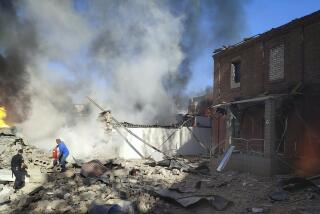Problems surface at another nuclear reactor at Fukushima plant
- Share via
As a small crew of engineers and workers struggle through the night at the Fukushima No. 1 power plant to keep the reactor core at the No. 2 reactor cooled so that more radiation does not escape through what appears to be a small breach in the reactor containment vessel, concern is shifting to a spent fuel pool on the roof of the building housing reactor No. 4, where a fire occurred Tuesday.
Three explosions in the last four days have damaged the buildings housing reactors No. 1, No. 2 and No. 3, and the final explosion at No. 2 appears to have damaged the suppression pool, the part of the reactor containment vessel that quenches excess steam produced during the generation of electricity.
That explosion was followed by a spike in radiation levels at the facility that led to an evacuation of all but about 50 workers who are pumping seawater laced with boron into the reactor cores of all three reactors in an attempt to keep them cool and stave off a meltdown. But officials say radiation levels have since fallen and remain stable at relatively low levels.
Photos: Scenes of earthquake destruction
Nuclear authorities are particularly concerned because the fuel rods in reactor No. 2 were at least partially exposed to the air for more than 14 hours, long enough for substantial melting to have occurred.
If any of the fuel pellets have melted, experts say, they would have dripped to the bottom of the containment vessel, where there is still a significant level of water. For the present, at least, that should prevent further melting.
Reactors No. 4, No. 5 and No. 6 are not thought to present a threat because all were shut down for maintenance at the time of the quake. Even if they had fuel rods in place, as was the case for No. 5 and No. 6, the reactor cores would be relatively cold and would require little cooling, according to nuclear physicist Rizwan Uddin of the University of Illinois.
But each reactor has a spent fuel pool on its roof. Those are also not as hot as a shut-down reactor but they do require cooling, and all of them lost their cooling after the earthquake. A fire broke out Tuesday in the pool atop reactor no. 4, but was extinguished fairly quickly.
Initial reports attributed the fire to hydrogen gas generated by reaction of the zirconium sheathing on the fuel rods with water, which would suggest a fairly high degree of danger. On Tuesday morning, however, Anthony R. Pietrangelo, chief nuclear officer of the U.S. Nuclear Energy Institute, said the fire was actually a lubricating oil fire, which would be much less serious.
Reports from the scene indicate the water in the cooling pond is boiling vigorously and engineers fear it will soon boil away, exposing the fuel rods, which would allow them to melt. That could have even more disastrous consequences than a meltdown inside the reactor because the fuel rods in the pond are not enclosed in a reactor containment vessel.
Because of the heat and steam being generated by the pond, workers are having a hard time reaching it to pump more water in. One possibility that is being considered is helicopter water drops similar to those used on forest fires in California.
Photos: Scenes of earthquake destruction
thomas.maugh@.com
Times staff writer Ralph Vartabedian contributed to this story.






